DFA Panelists & Peer Readers
Round Three Panelists (2024-2026)
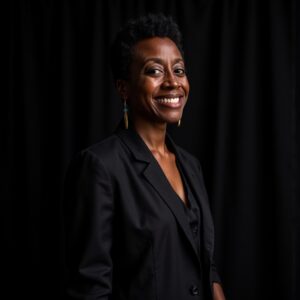
MK, an African-American woman with a short tapered haircut and dangling earrings wears a black vest and suit. Turned slightly to the left, their gentle gaze accompanies a wide smile.
MK Abadoo (they/she; Susquehannock/Piscataway; Ellicott City, MD), MFA, is an award-winning choreographer, educator, and cultural organizer. A Fulbright Fellow and associate professor in Virginia Commonwealth University’s Department of Dance + Choreography, MK’s devises intergenerational dance theater that is place-honoring and accountable to community partners across the southern states and beyond.
Named a choreographic “breakout star” by Dance Magazine’s “25 to Watch,” a MK’s nationally supported practice has been recognized with a 2022 Dance/USA Fellowship to Artists for leadership and commitment to art that drives social transformation. As a U.S. Fulbright Fellow in Ghana, they investigated contemporary dance forms with the Noyam African Dance Institute, the National Dance Company of Ghana, and rural youth in Dodowa. MK’s work has been supported by the John F. Kennedy Center for the Performing Arts, New England Foundation of the Arts, National Performance Network, Alternate Roots, University of Richmond, and toured nationally and internationally.
For nearly two decades, MK has trained the next generation of artists, educators, and organizers in dismantling systemic inequity, listening for understanding, building accountability, and cultivating deep connections across difference. Additionally, MK is a Trainer with the anti-racist organizer collective, the People’s Institute for Survival and Beyond and co-leads the first southern-based troop of the Radical Monarchs, creating space for young girls and gender expansive youth of color to form fierce friendships, celebrate their identities, and contribute radically to their communities
Photo by MK Abadoo & Momo AI Photo Editor

Anthony, a brown skinned, Pacific Islander is wearing a dark, navy blue button down collared shirt and standing in front of a tanned backdrop. His slightly wavy, black hair falls gently around his calm face. His deep brown eyes are warm and welcoming.
Anthoy Aiu (He/Him/They/Them/‘Oia; Lenape Hoking; New York, New York) is from O‘ahu, Hawai‘i, earned his MFA from the Conservatory of Dance at SUNY Purchase, where he created and produced eight new dance works and co-authored A Choreographic Workbook with his mentor, Kazuko Hirabayashi. Aiu is an artist, dancer, and choreographer deeply rooted in his Polynesian heritage. He founded `Avei’a in 2008 to showcase his culturally-grounded movement style and co-founded Te Ao Mana in 2016 to promote cultural expansion and amplify underrepresented Polynesian voices.
Aiu founded the Global Harmony Project in 2016, which builds communities through the creative process. His work has been presented at notable venues including Jacob’s Pillow, La MaMa, Peridance Center, the Hawai’i Triennial, Judson Church, Movement Research, Battery Dance, The Metropolitan Museum of Art, BAX, Brooklyn Ballet, Dixon Place, BronxNet Television, Webster Hall, the Kūkulu Art Exhibition, Indigenous Peoples Day, the NYC Dance Parade, Hawaiian Airlines Liberty Challenge, Hōkūle‘a’s Mālama Honua Worldwide Voyage, and the 92nd Street Y.
He has performed with prominent dance companies such as TAKE Dance, Kazuko Hirabayashi Dance Theater, Merce Cunningham, Dzul, American Ballet Theatre, and Paris Opera Ballet. Aiu has collaborated with various Pacific Island artists and has been a participant in Heiva I Tahiti since 2014. Recently, he worked with Ia Ora Te Hura on their Marama program (2024), winning several awards including “Toru” Hura Tau, “Best Hura Nui,” “Best Costume Vegetal,” and “Best Tāne Dancer.”
Currently, Aiu is a featured artist with Advancing Indigenous Performance (AIP) Native Launchpad and is working on several new projects that explore themes of belonging, indigeneity, queerness, and the application of ancestral knowledge in modern contexts. He is the choreographer for Lili’u Opera, a work funded by a SHIFT grant from the Native Arts and Cultures Fund, based on the forced house arrest of Hawaii’s Queen, Lili‘uokalani. Additionally, Aiu is a co-creator of Tatou Festival (formerly Heiva Pasifika NYC), the first large-scale Pacific Island festival in New York City, created by and for Ta’ata Moana (Pacific Islanders), and Mana Manahata, a grassroots initiative focused on providing representation and space for Pacific Island cultural artists. He is currently developing a new work titled Walking Rocks, inspired by the modern Hawaiian mo‘olelo of the same name and dedicated to na kia’i (protectors) of Mauna Kea.
Photo credit: Stefan Mreczko
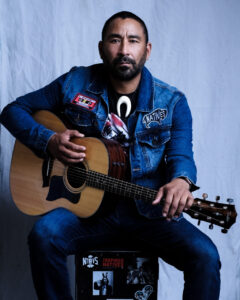
Qacung sitting with guitar
Qacung Blanchett (him; Tlingit Áani; Juneau, Alaska) is a performing artist, a multi-media producer, and an art and culture educator. Qacung is a founding member of the Alaska Native tribal funk & Inuit soul group, Pamyua, and is the creator and founder of Áak’w Rock, currently the only Indigenous music festival in the U.S. In addition to his 30-year performance and producing career, Qacung has a passion to work for Indigenous people. He has served in leadership roles with the Alaska Native Heritage Center, First Alaskans Institute, Pamyua Inc., and other arts, culture, and community service entities. He served on the Board of Directors of the Western Arts Alliance and chaired the Advancing Indigenous Performance program. He also serves as a Board of Director with the Alaska Humanities Forum. In 2022, Qacung was mentioned as The Kennedy Centers Next 50. He is a 2022 United States Artist Fellow and is a recipient of the 2021 Native Arts and Culture Foundation SHIFT- Transformative Change and Indigenous Arts award. He is a 2019 Dance/USA Fellowship recipient, a 2019 & 2016 recipient of the Rasmuson Foundation’s Artist Fellowship, and a 2015 National Artist Fellowship recipient through the Native Arts and Culture Foundation. Qacung is a global citizen whose Indigenous and black roots guide his leadership and artistic vision.
Photo credit: Joy Demmert

Alejandra is a white Latina woman sitting at a desk with her hands clasped. She is joyful, looking directly at the camera with a smile. She is wearing a black shirt with a lime green jacket and a few thin necklaces. Her shoulder length brown hair is down with a slight curl, parted to the left. Behind her a plant, bronze light shade and a dark colored wall, and at the desk an open laptop, book, and glass of water on a coaster.
Alejandra Duque Cifuentes (she/her; Nisqually; Lacey, WA) is a cultural strategist and advocate working to advance a more just, equitable, and inclusive arts and cultural ecology by developing measures so that arts workers, businesses, and organizations can thrive. Her work is of particular significance to individual arts workers who have been historically under-supported, including BIPOC, immigrant disabled, and low-income artists as well as small-budget organizations. She brings 15+ years of experience and expertise in strategy, general management, fund development, community organizing, arts education, professional development, and artistic production. Her professional and educational background encompasses business, creative, and civic realms, including a BA from Columbia University School of General Studies in theater directing and an early career as a theater artist, stage manager, and arts educator in music, theater and dance. She is known for her ability to get results and draws on her deep community relationships to drive accountable collaborations based on trust and data.
In 2022 after a 7-year tenure at Dance/NYC, she established ADC Consulting, a boutique arts consultancy firm, in order to equip mission-driven organizations to create long-term cultural impact through research, grant making, advocacy, project management, and organizational change. She sits on the board of Nonprofit New York and is a member of the leadership council of Creatives Rebuild New York. She identifies as a white, immigrant, latina woman, who believes healthy communities need a strong arts and culture sector. Originally from Medellín, Colombia, after living in NYC for 16 years, she has made a new home in Lacey, Washington with her partner and dachshund pup.
Photo credit: Jenny Roso Photography
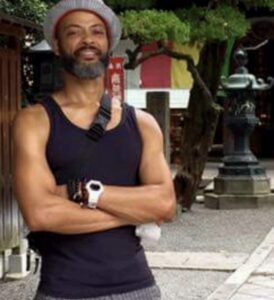
A man stands outdoors with arms crossed, smiling slightly. He is wearing a light-colored hat with a red band, a black tank top, patterned shorts, and a white wristwatch. A crossbody strap runs across his chest. Behind him are trees, colorful banners, and a stone lantern in what appears to be a courtyard or garden setting.
A man stands outdoors with arms crossed, smiling slightly. He is wearing a light-colored hat with a red band, a black tank top, patterned shorts, and a white wristwatch. A crossbody strap runs across his chest. Behind him are trees, colorful banners, and a stone lantern in what appears to be a courtyard or garden setting.
Sekou Heru (he/him; Crow Hill; Brooklyn, NY) is a pioneering figure in the street and club dance community and a dedicated ambassador of its culture. With over 30 years of experience, he has been instrumental in preserving and sharing the social values and core elements of street and club dance. His expertise has taken him across the nation and around the globe, teaching and inspiring dancers of all levels.
Sekou continues to judge international dance competitions worldwide and has worked with major artists, including Mariah Carey, Michael Jackson, and Jazzy Jeff & The Fresh Prince. His dance talents have been featured in music videos for MC Lyte, Busta Rhymes, Clubland, Zoo, and the Pet Shop Boys’ ""Being Boring."" He has also appeared as a featured dancer in films such as Marci X and 25th Hour.
In addition to his performance career, Sekou is the founder and co-director of the MOP TOP Universal Club and Street Dance accredited program at Peridance Center in NYC. He has also developed his own teaching method, Housedance Rhythm Metrics, which breaks down the intricacies of house dance movement and musicality. Through his work, he continues to uplift and educate, ensuring that the culture’s rich history and essence remain alive for future generations.
Photo credit: Eriko

Julie B. Johnson, a Black woman with light skin, offers a soft smile with her head turned slightly sideways. She is wearing her signature teal, cat-eyed glasses; a dark olive-green, button-down top; a multicolor scarf; and coral-colored dangle earrings. Her curly/frizzy hair frames her face and shoulders. It is pinned back from her forehead and parted on the side, displaying a bold patch of gray (of which she is very proud).
Julie B. Johnson (she/her/hers; Muskogee/Creek; Decatur, GA) PhD is a dance artist and educator whose work centers on participatory dance and embodied memory mapping to amplify the histories, lived experiences, and bodily knowledge of Black women as a strategy towards collective liberation for all. She does this work joyfully with community partners through her creative practice, Moving Our Stories (established in 2015), and at Spelman College where she serves as an Assistant Professor of the Department of Dance Performance & Choreography. She brings this work to the publishing realm as a Co-Founder/Consulting Editor of The Dancer-Citizen, an online open-access scholarly dance journal exploring the work of socially engaged artists.
Johnson is a 2022-23 Dance/USA Artist Fellow; 2020-23 Partners for Change Artist through Alternate ROOTS and The Surdna Foundation; a 2021 Hambidge Center Distinguished Fellow; and a 2019 Black Spatial Relics Fellow.
Since 2019, Julie has focused on the intersections of dance and abolitionist feminism through community-oriented endeavors such as Dancing in Darktown, Idle Crimes & Heavy Work, For the Record… Dances to Stop Cop City, and The Georgia Incarceration Performance Project. She earned a PhD in Dance Studies at Temple University's Boyer College of Music and Dance, researching meanings and experiences of ‘community’ in Philadelphia-based West African Dance classes.
Photo credit: Phyllis Iller Photography (Melissa Alexander)
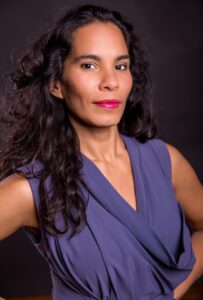
Mar Parrilla has a blue sleeveless top, hands akimbo, pink lipstick. She has brown skin, her dark brown hair is down, wavy curls. Born and raised in Boriken (Puerto RIco)- Mar is Indigenous Taino, Afro Boricua, HSP, and multilingual.
Mar Parrilla (she-ella; Massachusett, Wampanoag and Nipmuc territory; Roxbury, Massachusetts, USA) is a Taíno AfroBorikua and award-winning choreographer, educator, and community organizer. She is the founding Artistic Director of Danza Orgánica, a Boston-based dance theater company rooted in liberation, antiracism, antipatriarchy, and decolonial practices. A proud mother and interdisciplinary artist, Mar founded the Dance for Social Justice™ program and the annual We Create! Festival. Her work has been recognized by the BARR Foundation, the New England Foundation for the Arts, and the Boston Foundation, among others. Mar is also a Luminary Artist at the Isabella Stewart Gardner Museum and has led multiyear collaborations with the Aquinnah Wampanoag Tribe and Puerto Rico-based artists through Proyecto Melaza. She has taught since 1998 in K–12 and higher education, integrating decolonial approaches into her pedagogy. Fluent in five languages, she is currently learning her Taíno Arawak language and proudly honors her lineage of artists, healers, and visionaries.
Photo credit: Ernesto Galán

A brown skinned person in a black t-shirt, with long, straight black hair and brown eyes has a wide smile while looking at the camera against a gray background.
Movement artist and writer Bhumi B Patel (she/they; I’m on the ancestral and contemporary unceded land of the Chochenyo Ohlone people colonially named Oakland, California) directs pateldanceworks and is a queer, desi, home-seeker, and science fiction choreographer (she/they). In its purest form, she creates performance works as a love letter to her ancestors. Patel seeks to create movement at the intersection of embodied research and generating new futures, using improvisational practice for voice and body as a pursuit for liberation. Patel tends to her desires to create liberatory, nourishing community spaces through dancing, choreographing, curating, teaching, and scholarship.
Patel earned her MA in American Dance Studies from Florida State University and her MFA in Dance from Mills College. She is a member of Dancing Around Race and engages with curatorial practices for both performance and written publications. She has presented her choreographic work in the Bay Area, Manoa (Hawai’i), Los Angeles, New York, and Columbus (Ohio). Her research has been presented at the Dance Studies Association annual conference, Performance Studies international, the Asia Pacific Dance Festival Conference, the National Women's Studies Association annual conference, the Popular Culture Association annual conference, the International Conference on Movement and Computing and other symposia. Bhumi is a 2022-2023 Dance/USA Fellow and a 2023 YBCA 100 Honoree. Making art is her way of tracing the deeply woven connections in which we live–past, present, future–as a way to build communities of nourishment and care.
Photo credit: Lydia Daniller

A close-up portrait of a person with long dark hair, looking directly at the camera. She has a small nose stud, subtle makeup with defined brows and dark pink lipstick, and is wearing a white top with a black abstract pattern.
Shireen Rahimi (She/Her; Ohlone/Bay Area, CA), known as Shea, is an accomplished Iranian-American dancer, event producer, and mental health advocate based in Oakland, CA. Her ballroom journey began in 2012 when she relocated to Brooklyn, NY, where she quickly joined the renowned Iconic House of Mizrahi in the mainstream scene and the Kiki House of Unbothered Cartier in the Kiki scene. As a founding team member of Open To All Entertainment NYC (@opentoall.ent), the largest ballroom entertainment company, Shireen has played a pivotal role in shaping the industry. She is also the Co-Founder of Oakland To All (@oaklandtoall), the Bay Area's first and only ballroom entertainment company, and holds the esteemed title of founding godmother of the Kiki House of FuBu (@houseoffubu).
Beyond her accomplishments in ballroom, Shireen is a talented dancer and serves as the company manager for Les Ballet Afrik Dance Company (@LesBalletAfrik). Recently, she was appointed assistant choreographer for the reimagining of the Broadway classic CATS, specifically "The Jellicle Ball," working alongside acclaimed choreographers Omari Wiles (@Omari_Wiles) and Arturo Lyons (@Arturo_daengineer). This project represents a groundbreaking fusion of ballroom and musical theater.
Shireen's dedication to her craft extends to her role as a bi-coastal event producer, collaborating with Works & Process to orchestrate demo balls at prestigious venues, including Lincoln Center, the NY Public Library for the Performing Arts, Brookfield Properties at Manhattan West, and the Guggenheim. Passionate about mental health awareness, Shireen actively uses her platform to advocate for inclusivity and support within the dance community.
Photo credit: Kia Labeija

Judith Smith, a white woman is in a power wheelchair. She has long gray hair and is wearing a black sleeveless shirt with arm showing. She dances with Sonsheree Giles, a white non-disabled dancer who is also wearing black and has her bare back to the camera. Sonsheree is leaning into Judith and her power wheelchair and Judith rests her head on Sonsheree's shoulder. They are in a beam of light with a white floor and black background
Judith Smith (She/hers; Huisun, Land of Lisjan Ohlone) is a Founding Member and Director Emerita of AXIS Dance Company, is one of the world’s driving forces in physically integrated dance. Under Judith’s direction AXIS commissioned more than 35 works from the nation’s best choreographers and composers; toured to over 100 cities and appeared twice on FOX TV’S So You Think You Can Dance. She led the development of the field’s most extensive integrated dance education/outreach programs with a range of programs serving all ages, abilities and interests from recreation to the pursuit of a professional career.
Her advocacy/equity work led to the first-ever National Convening on the Future of Physically Integrated Dance in the USA. This project culminated in an extensive report and the launch of the AXIS Artistic Advancement Platform to Advance Artistry, Opportunity and Equity for Dancers with Disabilities. She was instrumental in the creation of the Dance/USA Deaf and Disability Affinity Group.
Judith has received many awards including an Isadora Duncan Dance Award for Sustained Achievement and the O2 Initiatives Sabbatical Award. She has been one of Theatre Bay Area’s 40 People That Have Changed the Face of Bay Area Theatre and was inducted into the Alameda County Women’s Hall of Fame. She is extremely honored and humbled to have received Dance/USA’s Honors Award in 2022. Since retiring from AXIS in early 2018, Judith has continued work in the field of dance and disability. Her email is judithsmith313@nullgmail.com
Photo credit: Andrea Basile
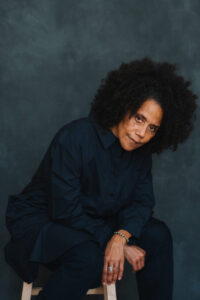
amara tabor-smith is a honey brown skinned Black woman with hair in a large curly Afro. She is leaning sideways looking at the camera wearing a dark blue long sleeve shirt
amara tabor-smith (she/they; Huichin Ohlone; Oakland, CA) is a choreographer, performance maker, cultural worker, Conjure artist, and the artistic director of Deep Waters Dance Theater based in unceded Huichin Ohlone territory/Oakland, CA. Her interdisciplinary site-responsive and community specific performance making practice utilizes Yoruba Lukumí spiritual technologies to address issues of social and environmental justice, race, gender identity, and belonging. amara’s work is rooted in Black, queer, feminist principles that insist on liberation, joy, home fullness and well-being. She is a 2024 recipient of the Guggenheim Fellowship award. Other grants and awards include, American Academy of Religion’s Religion in the Arts Award, the Rainin Arts Fellowship, Dance/USA Fellowship, United States Artists Fellowship, Urban Bush Women Choreographic Center Fellowship, Creative Capital, MAP Fund and A Blade of Grass. amara is currently a teaching artist in residence at Stanford University.
Photo credit: Robbie Sweeny
Round Three Peer Readers (2024-2026)
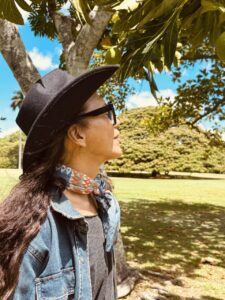
Sami L.A. Akuna, is in their third year as one of the directors at the Hawaii LGBTQ+ Legacy Foundation. Sami serves direct populations of kupuna, rainbow youth, and the MVPFAFF+ community. Kapaemahu, Nā Pohaku Ola is just one specific type of programming Same directs, which helps to inform and educate both locals and visitors in the perpetuation of cultural practice and protocols surrounding this sacred and almost forgotten site. Sami is also a dance lecturer at the University of Hawaii at Manoa where Sami curated and teaches the very first movement based Queer Exploratory Dance class in the nation. Introducing the students to genealogical movements, embodiment, and choreography from former drags shows that were based in Hawaii. The class also engages with the rainbow community through outreach, support, and attending and performing in queer spaces or events. Including the Pride Paina La Ohana, Universal Showqueen Pageant, and the Honolulu Pride Festival just to mention a few. The course is now in its third year and has continually advanced more community engagement for the students with a focus on serving the MVPFAFF+ populations. Sami still performs and continues to create work through movement, identity, and sense of place through the lens of being a kānaka artist and māhū.
Sami L.A. Akuna (Māhū; Honolulu, Kingdom of Hawaii), is in their third year as one of the directors at the Hawaii LGBTQ+ Legacy Foundation. Sami serves direct populations of kupuna, rainbow youth, and the MVPFAFF+ community. Kapaemahu, Nā Pohaku Ola is just one specific type of programming Same directs, which helps to inform and educate both locals and visitors in the perpetuation of cultural practice and protocols surrounding this sacred and almost forgotten site. Sami is also a dance lecturer at the University of Hawaii at Manoa where Sami curated and teaches the very first movement based Queer Exploratory Dance class in the nation. Introducing the students to genealogical movements, embodiment, and choreography from former drags shows that were based in Hawaii. The class also engages with the rainbow community through outreach, support, and attending and performing in queer spaces or events. Including the Pride Paina La Ohana, Universal Showqueen Pageant, and the Honolulu Pride Festival just to mention a few. The course is now in its third year and has continually advanced more community engagement for the students with a focus on serving the MVPFAFF+ populations. Sami still performs and continues to create work through movement, identity, and sense of place through the lens of being a kānaka artist and māhū.
Photo credit: Ricard Barlett

Hanaah Bates stands facing the camera wearing a black and white striped dress with shoulder length brown hair and white earrings. In the background is a patterned wall in dark earth tones and various geometric shapes.
Hanaah Bates (she/her; Munsee Lenape) is an arts administrator, educator, arts advocate and choreographer based in the NYC area. Hailing from Syracuse, NY, she graduated from Florida State University where she received a BFA in Dance and Spanish and studied under teachers such as Dan Wagoner, Gerri Houlihan and Lynda Davis. She has performed in works by Jawole Zollar, Jodi Melnick, Steve Koester, and Alan Danielson, in addition to producing her own solo work. Hanaah was the recipient of the Undergraduate Research and Creative Endeavors Award, which allowed her to travel to Panama to study traditional dance techniques. This sparked her curiosity in forms of cultural expression from the Hispanic diaspora and instilled a love of traveling and arts-based research. Hanaah later served as the Project Manager of “100 Years of Flamenco in New York,” a multimedia exhibit curated in conjunction with the New York Public Library for the Performing Arts in 2012-13.
Hanaah began her arts administration career in 2011 when she joined Flamenco Vivo Carlota Santana as Company Manager and went on to hold multiple roles in programming and fundraising before being named Executive Director in 2017. She completed the Executive Program in Arts & Culture Strategies through National Arts Strategies and Penn University in 2016 and the 2019-20 Adaptive Leaders As Cultural Innovators NYC cohort through EmcArts. Hanaah served on the Emerging Leaders of New York Arts Board of Directors as co-chair from 2016-2018, working to cultivate new generations of arts leaders. She was elected a member of the Steering Committee of the Arts for All Abilities Consortium from 2016-2017, supporting accessible arts education programs for students with disabilities in NYC public schools. She currently serves as Co-Chair of the DanceUSA’s Managers Council, spearheading monthly discussions and professional development.
Photo credit: Didi Frechette

Image description: A dark brown skinned woman, long black hair, wearing a white shirt, khaki waistcoat and skirt, with a nose ring on the right side of her nose per the Tamil tradition smiles. Photo: Nathan Cornetet/Fusion Photography.
A three-time Indian National Champion of Bharatanatyam and a recipient of the Dance/USA fellowship funded by the Doris Duke Charitable Foundation for her work addressing social justice in Bharatanatyam, Dr. Prathiba Batley (She/her; Shawnee, Osage, Hopewell Culture) is an international dancer with over 300 performances to her credit. Many of her productions highlight contemporary social and cultural issues while others underscore the intricacies of classical literature. She has been invited to perform at TedxTWU, is writer, producer, and protagonist of Dirty Secrets – a dance short film, choreographer of the Great Celestial Cow, and director/creator of productions such as Enticing Anklets (Konjum Salangai) and The Ballad of the Gypsy (Kuravanji). In 2012 she established Eyakkam (Movement) Dance Company – a 501(c)(3) not-for-profit dance company
Photo credit: Nathan Cornetet
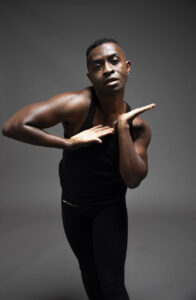
A darker hued African American male presenting person wearing a black tank top and black leggings, with a soft flat top and hands nears their chin palm sides visible, making a diagonal.
BERNARD BROWN (He/They; Tongva/Chumash; Los Angeles, CA) is a performing artist, choreographer, filmmaker, educator, and arts activist working at the crossroads of Blackness, Queerness, and belonging. As executive artistic director of Bernard Brown/bbmoves, a social justice dance theater company, he choreographs for stage, specific sites, film, and opera. His work has been presented across Africa, Asia, North America, and Europe, including Seoul International Dance Festival, On The Boards (Seattle), Centre de Developpment Choregraphique La Termitierre (Burkina Faso), Dance Camera West, Dance Camera Istanbul, American Dance Festival’s ADF Movies by Movers, Roy and Edna Disney/California Arts Theater, University of Chicago, and Royce Hall, amongst other venues. Commissioning organizations include The City of Los Angeles, UCLA, Santa Monica Symphony, Dance Mission Theater, the Fowler Museum, South Chicago Dance Theater, Lula Washington Dance Theatre II, Pieter Performance Space, and a host of universities and community organizations. Brown has developed work in residencies with The Music Center, Johns Hopkins University, and Dance Italia. For nearly three decades, Brown has collaborated with leaders of the dance field including Lula Washington Dance Theatre, David Rousseve/REALITY, Donald McKayle, Rennie Harris, Rudy Perez, Pat Taylor, Doug Elkins, Jessica Lang, and Lucinda Childs, to name a few. By invitation, he has joined casts of productions like the Kennedy Center’s Masters of African American Choreography, Los Angeles Opera’s “AIDA,” and Robert Wilson’s Letter to a Man with Mikhail Baryshnikov. He is a proud member of the American Guild of Musical Artists. As a sought-after educator, Brown has conducted workshops, lectures, presentations, and master classes internationally, namely in Israel, Burkina Faso, Panama, Malta, S. Korea, and Brazil, and across the US, sharing his inclusive pedagogy. He is a core member of Street Dance Activism and an ongoing collaborator with Dancing Through Prison Walls, an aboltionist project. His activism has been featured in Dance Magazine, the Los Angeles, and New York Times. A first-generation college graduate, he is a Professor of Dance at UC San Diego, a Certified Katherine Dunham Technique Instructor, and currently a California Arts Council Established Artist Fellow. The Los Angeles Times has called him “…the incomparable Bernard Brown…”
Photo credit: David Arenas

Sharon is a mocha-skinned, black woman with dark, short, and curly hair, who is wearing a hot pink dress. She is leaning against a brick wall with her left, muscular arm propped up on a stair railing. She is staring at the camera, which is off to her right side, while holding an open, yet quiet, closed-mouth smile.
Sharon C. Carelock (she/her; Mvskoke (Muscogee); Atlanta, GA) is a storyteller, and she uses a myriad of artistic mediums to tell stories. Weeks after performing her first aerial silks show, Sharon made her company debut in Burning Bones Physical Theatre’s presentation of Small Mouth Sounds by Bess Wohl. Since graduating from the Florida State University School of Dance with an MFA, Sharon has worked in several artistic processes, most recently with Sammy Spriggs and …I feel that. Sharon’s latest choreographic work, which is called Witnessing a Light Bath and made possible due to DanceATL’s A.M. Collaboration project and a CREAT ATL grant, uses the story of Bathsheba to talk about having Seasonal Affective Disorder. Sharon cares deeply about honing her many crafts and skills, so she can shape and present her narratives. That means taking multiple classes a week to feed her sense of exploration. Sharon is grateful to her husband, Bryan, and her tribe of friends for their support.
Photo credit: Emily Iva Photography

Colin, a white man with gre-brown hair and prominent blue blue glasses peers into the camera with his cat Griffin, a brown tabby cat with green eyes.
Colin Clark (he/him; Tkaronto; Toronto, Ontario) is a computational media artist, designer, and developer of community-led technologies. He improvises electronic music with Bitstance, makes algorithmic video art that explores sonic processes, and develops open source software and hardware for intermedia art used by artists worldwide. Colin co-directs Lichen Community Systems, a non-profit worker cooperative dedicated to creating expressive technologies and systems that are designed by, accessible to, and ownable by communities. Since the 1990s, Colin has influenced the growth of inclusive design methods in Canada and developed accessible systems, policy, and infrastructure internationally. He holds an MFA in Interdisciplinary Art, Media and Design from OCAD University, where he is also Adjunct Professor in the School of Graduate Studies.
Photo credit: Colin Clark
Kenna-Camara Cottman (any; Dakota/Ojibwe) is Black, non-binary, a parent, a child and a community member in Mni Sota Makoce. Kenna may be known for her work with Voice of Culture, as a dancer, choreographer and educator, but it could also be noted that Kenna is also a practitioner of all the elements of Hip Hop, a community radio host and DJ, a high school theater director, a certified Yoga teacher, and an improvisational vocalist. Kenna is a abolitionist non-violent transmitter and receiver and also in the practice of creating and experiencing Black space for cultural arts and liberation. Current projects include self study and reclamation through the Body Prayers cycle. Kenna is the child of Ancestors Beverly and Bill Cottman, community parents & artists each in their own rights. Kenna is the mother of Yonci Peaceful, a well known and respected artist, writer, DJ, activist and youth worker; and Ebrima Baye, an accomplished soccer player, golfer, and enthusiastic gamer.
www.voiceofculture.org for more information on Kenna's forward facing projects.

Italian man with jean jacket and Cazal glasses.
Anthony Denaro (he/him; The area where Lubbock, Texas is located was once part of the territories of the Lipan Apache and Comanche tribes.) explores the design, sustainability, history, and community of Hip Hop. With a futurist mindset, YNOT’s work manifests in dance, typography, music, and architecture. He has mainly participated, researched and competed in the dance form of Breaking for over 25 years. Dance in his life serves as a catalyst for inspiration, for creating awareness of movement and self-expression, and allowing for investigation within other artistic mediums. In YNOT’s vision of the sustainability of Hip Hop, teaching and mentorship are paramount. He believes education allows us to better understand the world in which we live. Through education, we become thoughtful about what happens around us. It is the most powerful weapon. Alongside his dance and professorship, YNOT both physically and digitally creates two and three dimensional art pieces that construct a possible future of the Hip Hop aesthetic.
Photo credit: selfie
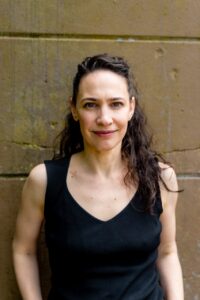
A white woman in her 40s with long dark hair wears a tank top and smiles at the camera.
Kate Elswit (she/her; Ramaytush Ohlone; San Francisco, CA / London) is a scholar–artist whose research on performing bodies combines dance history, performance theory, cultural studies, medical humanities, experimental practice, and technology. Her work articulates how information is stored in and transmitted through bodies in performance. For the past decade, she has been collaborating with Harmony Bench to bring dance and experimental digital practice into conversation, including through the AHRC-funded projects Visceral Histories, Visual Arguments: Dance-Based Approaches to Data (2022-25) and Dunham’s Data: Katherine Dunham and Digital Methods for Dance Historical Inquiry (2018-22), which won the ATHE-ASTR Award for Excellence in Digital Theatre and Performance Scholarship. As Moving Data, their first commission was from the Whitney Museum of American Art for a series of dance history data visualizations that appear in the Edges of Ailey exhibition (September 2024 – February 2025). Elswit’s print publications include the award-winning books Watching Weimar Dance (2014) and Theatre & Dance (2018). As a choreographer, dramaturg, and curator, she is committed to multiple possibilities, both implicit and explicit, for working between practice and research, and her collaborative projects have been shown internationally, including at ImPulzTanz, the Singapore International Festival of Arts, and Ignite! Festival of Contemporary Dance. She received her PhD from the University of Cambridge, and is now Professor of Performance and Technology and Head of Digital Research at the Royal Central School of Speech and Drama, where she is Co-Director of the Centre for Performance, Technology, and Equity.
Photo by Shoott, courtesy Kate Elswit

Jenn Freeman | Po’Chop is a Black queer woman with an afro. Her black hair is styled asymmetrically with curls spiraling down both sides of her face. Her eyes are adorned with purple eye shadow. She is wearing gold hoops and a turquoise button up shirt that features a red art deco pattern. A ray of light illuminates her face and shoulders while a shadow streaks across her forehead and right shoulder.
Jenn Freeman (she/her/they/them; Based on the aboriginal lands of several indigenous tribes including Potawatomi, the Odaw, and Ojibwe) is an interdisciplinary artist who creates and lives Chicago. Freeman, also known as Po’Chop, weaves dance, storytelling, drag and striptease together to create experiences that illuminate Black queer life. She is a co-founder of House of the Lorde, a multi-functional studio rooted in Black Feminist praxis. Freeman has collaborated with Jamila Woods, Anna Martine Whitehead and VAM Studio. Her work has been supported by Foundation of Contemporary Art, Urban Bush Women, United States Artists and Chicago Dancemakers Lab Artist.
Photo credit: Anjali Pinto

Female with long black hair, olive skin, brown eyes, longsleeve brown shirt
Keala Fung's (She/her; Kingdom of Hawaii, Honolulu HI) formal training in classical and contemporary ballet span decades. She acquired her Bachelors of Arts in Dance from the University of California, Irvine. Keala's disciplines of dance and movement include latin partner dances, burlesque, swing, aerial dance, Pilates, barre fitness, Yoga capoeira, and pacific island dances. She has toured and performed in various Tango, Burlesque, Salsa, and Contemporary dance companies and productions domestically and internationally. She currently dances for Tau Dance Theater and serves as the Outreach coordinator for the company. She performs with Honolulu’s Cherry Blossom Cabaret burlesque troupe, and Dancers Unlimited dance company as well. Traditionally, Keala's hula and ('oli) chant explorations started from a three month native Hawaiian encampment as protest on the sacred mountain of Mauna Kea and continues with the Kanakaole family who trace their family lineage to the goddess Pele of the volcano. Keala is a major contributor to the bi-coatstal dance company (New York City/Hawaii), Dancers Unlimited as its Hawaii coordinator who's current focus is on Edible Tales centering on Native Hawaiian wisdom and stories about food and ʻāina (land) into community-centered dance exploration, actions and solutions leveraging movement explorations as a way for the participants to process hands-on learning and land stewardship in a transformative way. Keala currently creates dance works which shares stories and celebrates sacred spaces, places, processes, and people who she loves.
Photo credit: Cheyne Gallard

A smiling person with short, natural hair is standing outdoors. She is wearing a black V-neck sweater and light blue jeans, with her hands tucked casually in her pockets. She looks directly at the camera with a warm, confident expression.
Robyn Gardenhire (She/Her; Los Angeles/California, CA) is the Founder & Artistic Director of City Ballet of Los Angeles, She began her training with Margaret Lynne Columbus and then went on to Los Angeles Ballet,she was granted scholarships and studied at SAB,ABT,San Francisco Ballet. Ms. Gardenhire was a company member of Joffrey II, Cleveland Ballet, American Ballet Theater & White Oak Project. She is a founding member of the SAB Diversity Committee, and on the board of the Ebell Club. She was responsible for ABT's diversity & outreach programs as well as offering 6 scholarships for six years to minority student's the first was Misty Copeland.
Photo credit: Leon Lee film maker
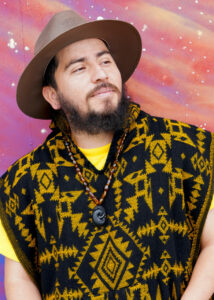
Gabriel "MoFundamentals" Gutierrez is leaning on a Galaxy mural backdrop, looking left in the distance slightly squinting. He's wearing a brown hat, yellow and white patterned poncho hoodie, yellow short sleeve undershirt, and amber necklace with an obsidian dragon-like pendant representative of the deity Quetzalcoatl.
Originally from Chicago, Gabriel (he/him; Chumash/ Tongva Gabrieleño; Los Angeles, CA) is an adult adoptee, first generation, street dancer, founder of MoFundamentals, and P'urhépecha artivist dedicated to highlighting the resiliency of foster-adoptee artists. His work centers on elevating narratives and lived experience of artists and culture bearers in Los Angeles who belong to: street dance, houseless, former foster, adoptee, and P’urhépecha communities. His contributions at the intersection of hip hop, street dance, arts education, and foster-adoptee advocacy have led to invitations to train at intensives hosted by Rennie Harris, being an ACTIVATE Cultural Policy Fellow to represent Los Angeles City District 1, piloting reentry through performing arts programs funded by the California Arts Council, being a 2022 DanceUSA Fellow to create the first foster-adoptee dance collective in the United States, and becoming a 2024 MAP grantee.
Photo credit: Leonardo Rivas
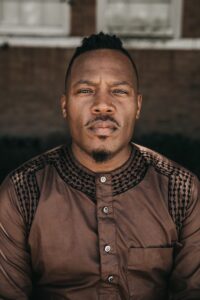
Black man pictured center. Brown shirt. Some hair on top and shaved on the sides.
Harrison Guy (He / Him; Karankawa/Ishak/Sana/Esto'k Gna/Coahuiltecan; Houston, TX) began dancing at Prairie View A & M University and continued his studies at the Alvin Ailey School in NY. He was a pioneer and founding member of two modern dance companies in Houston with Ken Epting and Dorrell Martin. In 2004 he founded Urban Souls Dance Company- a modern dance company based in Houston who focuses on providing a safe space for Black dancers. He has facilitated a cultural exchange in Kigali, Rwanda, and in 2015 was commissioned by Vanderbilt University to honor one of America’s most prominent composers, John Harbison. In 2016 he launched Houston's first African American Dance Festival. Harrison was the inaugural Artist in Residence at Rice University in 2019 where he presented a project called Black Bodies in White Spaces. Harrison has taught dance for over 20 years and is currently in the dance faculty at the Kinder High School for Performing & Visual Arts where he teaches Horton. He is a 2022 Dance/USA Artist Fellow made possible by the Doris Duke Charitable Foundation (DDCF) and he is one of the inaugural recipients of the BIPOC Art Network and Fellowship Artist Award 2023. Harrison was the inaugural Artist in Residence at Rice University through the CERCL Department where he presented a project for Black students and the community called Black Bodies in White Spaces. He is the Founder of the Charles Law Community Archive through the Black LGBTQ History & Heritage Project with the African American Library at The Gregory School. Harrison is the Director of Arts and Culture for the 5th Ward Community Redevelopment Corporation where he leads the 5th Ward Cultural Arts District and manages the Historic DeLUXE Theater. Harrison has created over 20 original works for Urban Souls Dance Company. He is currently choreographing Can We Know the Sound of Forgiveness, with composer Gabriela Ortiz commissioned for the Shepherd School of Music at Rice University, in collaboration with Carnegie Hall.
Photo credit: Taylor Jackson
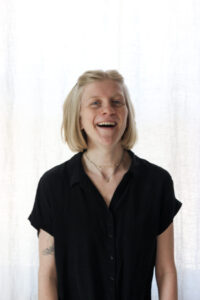
rachel is caught mid-laugh as she looks at the camera. She is a white femme with short blonde hair and blue eyes wearing a black shortsleeved button-up. Gold jewelry glints from her nose and neck; a thin lined moth tattoo peeks out from under one sleeve.
rachel hickman (she/any; Tiwa lands; Albuquerque, NM) a mover, thinker, maker born into a lineage of wide open, clefted ones. Both quilter and quilted, rachel spends time pulling at and tending to threads that serve to bind, heal, or conceal us. She is a grateful guest and steward in Albuquerque, NM - Tiwa lands, in ever-deepening relationship with roadrunner and datura kin. Part of Kinetic Light since 2019, rachel is currently the disability arts ensemble’s Access Manager + Cultural Steward. She revels in facilitating spaces for people to individually and collectively unravel their notions of accessibility, disability, care, and equity. rachel served as a Round Two Peer Reader for the 2021-2023 DFA program and has interned for Urban Bush Women’s Summer Leadership Institute. In Spring 2020, she graduated summa cum laude from Florida State University with a BFA in Dance. While at FSU, rachel was a Truman Scholar candidate and a recipient of the 2019 National AATI Essay Award.
Photo credit: rachel hickman

Black woman with a loc’d hair style and beautiful smile. Wearing bright green color top against orange background.
Tyra J (She/her; Chahta Yakni (Choctaw)) is a proud and active native of Mobile, Alabama. An esteemed educator with over a decade of classroom experience as dance teacher and director. she is a 2023 Klingenstein top three finalist for EL education. She js 200 hr Yoga Instructor and mindfulness coach. She is the 2023 Alabama Dance Fellow and a 2023 Dance USA/National Dance Fellow Finalist. Tyra J. is a graduate of NYU’s Tisch Dance Master of Fine Art degree program and has completed all levels of the Horton Pedagogy Training Program and Progressive Ballet technique. She is an undergraduate of the University of Alabama’s Department of Theatre and Dance Program where she performed and choreographed with the Alabama Repertory Dance Theatre. She is the Founder and Co- Artistic Director of the dance company INNERGY Inc. where their mission is to bring high quality dance experience to marginalized BIPOC communities around the world by curating dance productions and hosting master dance workshops.
Photo credit: Kevyn Bryant of Evolve Digital Marketing
Millicent Johnnie’s (My pronouns are flexible; Land of the Potano people and Black being bodies who have labored the land) work is an artist, advocate, educator whose work and research center on social justice and cultural representation, driven by early experiences with opposition. As a two-time United States Artists nominee, she has made significant contributions in dance, theater, film, and music. Her choreography, featured on ESPN and other major networks, reflects her innovative approach, further showcased in her role as Associate Artistic Director of Urban Bush Women and through her A&R work with Marvelous Enterprises. Johnnie’s stage and film work include projects like Bamboula: Musicians’ Brew, which inspired the short film Bamboula is Not Bamboozled, and La DiaBlesse Curse, developed with Trinidad and Tobago’s National Carnival Commission. Her hybrid film, Pulling Back the Curtain, explores how COVID-19 and systemic issues impact the Ballet world. Her theatrical credits, such as Cry You One and Frozen, along with directing West Side Story in South Africa and performing at the Olympics, highlight her global influence. Johnnie’s diverse artistic portfolio demonstrates her commitment to addressing cultural and systemic issues through various creative mediums.

Alison, a white queer femme, dances ankle deep in Lake Michigan, as waves crest and crash behind her. She is wearing black shorts and a black mesh cropped shirt and is gazing upward and to the left. Her right fingertips graze her right shoulder, golden hour light on her face.
Alison Kopit (she/her; Council of the Three Fires: the Ojibwe, the Odawa, and the Potawatomi, as well as the Myaamia, Ho-Chunk, Kickapoo, Menominee, Peoria, and Sac and Fox Nations; Chicago, IL) is a queer and disabled cultural worker, access dramaturg, and improvisational movement artist based between Chicago and New York City. She is interested in creative and access-centric approaches to art and cultural work and working with organizations and artists to build capacity and commitment for intersectional, sustainable access practice. She is interested in using relationship and collaboration as key parts of access practice, working with distanced connection, and creating art that evokes the feeling of sharing a secret. Her current access dramaturgy collaborations include Dan Fishback’s Dan Fishback is Alive, Unwell & Living in His Apartment (Winter, Joe’s Pub) and Ryan J. Haddad’s Hold Me in the Water (Spring, Playwrights Horizons). She co-leads the Pay Rate for Access Workers Now (PRAWN) project with Madison Zalopany. She developed her access dramaturgy practice in Ryan J. Haddad’s Dark Disabled Stories (Spring 2023, produced by the Bushwick Starr, presented by The Public Theater) and Maggie Bridger’s Radiate (Winter 2023, Chicago Dancemakers Forum & Links Hall). She won the Michael Feingold award for Dramaturgy in the 2023 Obie Awards and is an Action Movement Play resident at Movement Research (with support from the Mellon Foundation) this month. She holds a PhD in Disability Studies from the University of Illinois at Chicago.
Photo credit: Clarissa Worcester
South Minneapolis native, Maia Maiden aka Rah Fyah (She/Her; DAKOTA AND ANISHINAABE; Minneapolis-St. Paul, MN), is an award winning visionary arts leader, strategist, and curator of transformative experiences at the intersection of education, equity, and cultural expression. Representing Hip Hop culture, she leads with deep-rooted commitment to community-centered innovation and systemic change through the arts. She is the Executive Director & Curator of Maia Maiden Productions-an award-winning performing arts presenter led by BIPOC women and grounded in the power of Hip Hop culture. Based in the Twin Cities, MMP stands at the intersection of culture, innovation and impact-championing community through a deep commitment to authenticity, creativity and liberation in the arts. As the Director of Arts Learning and Community Engagement at the renowned Ordway Center for the Performing Arts, Maia has redefined what it means to build authentic engagement. Honoring team collaboration, her leadership has helped support meaningful arts experiences for tens of thousands annually—on stage at the Ordway, in classrooms and community partnerships across Minnesota; forging cross-sector relationships that elevate BIPOC artistry and creative access.

dark brown woman, with a low natural hair cut is looking over slightly over shoulder directly at camera. A simple cat's eye shape her eyes, her glossed lips are parted and jaw relaxed while wearing a two tone color blocked sweater with a white stripe and light teal ribbing and blocking. A smooth flat-head nose piercing and medium-size diamond shaped black earrings adorn her.
cat mahari's (she/her/blk; Ojibwe, Council of 3 Fires, Potawatomi, Kickapoo, Peoria) practice is built from a richly layered body history, stemming from an archive of research, physical training, and an intent to manifest an intellectual, material, and informal legacy of Black liberation through documentation. She is a 2025 Chicago Dancemaker Lab awardee. In 2021, she was named a City of Chicago Esteemed Artist Awardee and received a 3Arts Award. Additionally, cat is a 2024 MCA-Chicago New Works Initiative Commission, 2023 MAP Fund microgrant, and 2022 Foundation for the Arts Emergency funding recipient for blk ark: the impossible manifestation. Her genre-defying work, includes the ongoing un-disciplinary explorations "the mixtape series: violent/break, volumes I and II", "Sugar in the Raw", and " MAPS - migration pressures and strategies". mahari aka culture free aka abstrakt blk aka mississippi is an active culture bearer. She holds a BFA from UMKC-Conservatory and a MA in Performance, Practice, and Research from the Royal Central School of Speech and Drama at the University of London.
Photo credit: Maria J Hacket
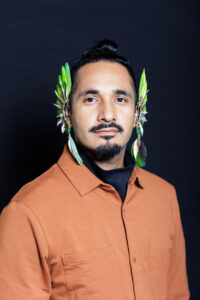
Julio Medina smiles softly at the camera, his body slightly angled with his right shoulder forward. He is wearing a burnt orange shirt with a black turtle neck underneath and bright green and white feather earcuffs. Julio is an Indigenous Mexican with brown skin and dark black hair styled into a top bun, sides shaved, with a mustache and short goatee—photo by CatMax Photography.
Julio Medina (he/him; Muscogee; Atlanta, GA) is an indigenous Mexican American artist from LA now based in Atlanta. His work focuses on the metaphysics of dance, considering resilience, connection, and restoration. Medina is an Assistant Professor of Dance at Emory University in Atlanta. Medina’s work has been presented at The New Dance Alliance Performance Mix Festival in Brooklyn (2017), the ConderDance Festival in Tempe, AZ (2018), and the American Dance Festival Alumni Concert (2018). Medina earned his MFA at UCLA's Department of World Arts & Cultures/Dance. Medina toured with David Rousséve/REALITY, in the evening-length work Halfway to Dawn. Julio’s current research explores his Mexica roots, taking inspiration from Mexica cosmology and mythology. When not teaching or performing, Medina practices yoga, boxing, and gardening.
Photo credit: CatMax Photography

Ariane is pictured with shoulder-length, curly brown hair, gazing directly at the camera with a calm, neutral expression. She wears minimal makeup and a dark sleeveless top, against a light background.
Ariane Michaud (she/her/hers; Narragansett Indian Tribe) is a producer focused on cultivating communities that support the arts and promote social justice. Her passion for dance has led her to diverse roles within the industry, including serving as a producer for DANCE NOW NYC, a communications specialist for JUNTOS Collective, and the North American Tour Manager for Wang Ramirez. As an independent consultant, she has provided strategic planning, production, and project management support to individuals and nonprofit organizations. Ariane became the Executive Producer of The Conference for Research on Choreograph Interfaces (CRCI) in 2019, and has since led multiple large-scale conferences and projects, including the Dances with Robots Podcast, released in Fall 2023, for which she also served as the script-writer and co-host. In 2024, Ariane founded Consciously Produced, a company specializing in creative productions that foster connection and community.
Photo credit: Pedro Jorge Photography

The portrait features Keith Miller Jr., a young Black man with a thoughtful and intense expression. His hair is styled in medium-length dreadlocks, hanging loosely around his face. He wears a dark, intricately beaded shirt with a high collar, adding a subtle elegance to his appearance. The photograph is taken in black and white, emphasizing the texture of his skin and the depth of his gaze. His eyes, partially shaded by his dreadlocks, convey a sense of introspection and poise.
An award-winning educator, multimodal artist-researcher, and critically acclaimed YA novelist, Keith’s (he/him/his; Muscogee, Cherokee, and Creek (Georgia)) work reimagines masculinity, sexuality, and intimacy through the lens of healing literacies. Keith is also the author of the PRITTY series with HarperCollins, Pritty (2023) and Togetha (2025), was a Lambda Literary Finalist for YA LGBTQ+ fiction. He has a Master’s in Educational Psychology from University of Wisconsin–Madison and a Master’s in Fine Arts from St. Francis College in Brooklyn, NY. When he’s not creating art, he can be found reconnecting with young adult changemakers from programs he’s run over the years, Keith can be found working through his company, Healing By Any Means, LLC, which powers people, projects, and research to maximize healing potential.
Photo credit: Alexey Kim

A person poses against a dark background, wearing a black beanie, round glasses, a dark blazer, and a black turtleneck. He holds a bouquet of bright yellow sunflowers and looks slightly upward with a calm, confident expression.
Toran Xavier Moore (He/Him/His; Tongva; Los Angeles, CA) is a southern native/LA creative who can often be found as an Arts Administrator, Stage Manager, Producer, and Choreographer. As a dance artist, Moore’s career highlights include performing with the Eclectic Dance Company, sharing his step tradition with youth in Oahu at the Queen Lili‘uokalani Trust's ʻŌlino Arts Program, and Lead Choreographer (Try/Step/Trip) and now Choreographer with Odyssey Theatre ensemble’s SoCal Premiere of Kill Move Paradise. As Producer and Creative Manager, Moore has worked in and with theaters internationally, including Terra Kulture, Yerba Buena Center for the Arts, CalArts Center for New Performance, The Kennedy Center, and many others he’s grateful to have shared space in. When not dancing, Toran serves as the Director of Programs for The International Association of Blacks in Dance. Moore holds degrees from California Institute of the Arts (M.F.A) and Alabama State University (B.A.)
Photo credit: Joan Osato
Jasmine Orpilla (she/her, they/their, isuna, siya; Tongva lands, Tovaangar) is a transdisciplinary Ilokana/x-American multilingual vocal performance artist, dancer and operatic composer of experiential installations rooted in her lifelong study of and ongoing practices in Filipino combat systems, dance, indigenous and ancient music of the Philippines. Based on in-depth ethical research centering the inherited and lived experience of the systemically silenced, Orpilla’s art is committed to further honoring the complex intersectionality of the Fil-Am body in full agency.
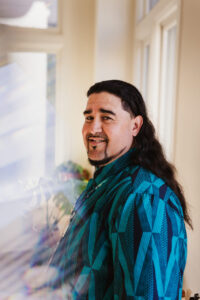
A man with long brown hair smiles into the camera wearing a Native Hawaiian print shirt. The color of the shirt is teal and black.
James Pakootas (He/Him/His; Residing on the lands of The Spokane Tribe and I come from The Colville Confederated Tribes who also share relation to these lands and it's peoples) (Colville Confederated Tribes), is a modern-day story weaver. He is an award-winning vocalist, producer, and filmmaker who cultivates change through the power of words. James comes from people whose future, present and past are expressed through art, song, and movement. As a vocalist who creates conscious hip hop and spoken word poetry, he carries on this tradition. James tells stories - stories that empower, stories that fascinate, and stories that speak truth to our existence. The core of his content speaks to the resilience of the human spirit, a deep understanding of trauma, and connection; the never-ending pathway back to ourselves. Whether creating interdisciplinary stage productions with his artist collective, creating new bodies of work in music and film, or mentoring teams of multi-generational artists, James influences people to rise above their circumstances and chase dreams worth living. James has appeared at many famous music venues, including The Kennedy Center for Performing Arts, The Smithsonian National Museum of the American Indian in NYC, and The National Museum of Jazz in Harlem. Pakootas has performed internationally and collaborated with Joy Harjo, Pura Fe, Monique Mojica, Roberta Uno, Pamyua, Tau Dance Theater, Jellybean Johnson, Charly Lowry, Miss Chief Rocka, Gunner Jules, Elexa Dawson, Bazille, Mali Obomsawim, Marc Bamuthi Joseph, Maura Garcia, and Delbert Anderson.
Photo credit: Emmett Photo

Kamakoa Page Zablan - Is a native Hawaiian ballerina shown here in Manaola designs. She has green eyes and curly brown hair, styled slicked back and adorned with Monstera Leaf.
(Her/She; Kingdom of Hawaii; Honolulu, Hawaii) "Aloha, I am a native Hawaiian artist performer and educator specializing in classical ballet. I dance professionally with an indigenous performing company ""Tau Dance Theater"" which promotes awareness to Polynesian culture through dance Hula/Ballet/Modern. I also am Owner/Director of a dance school ""Page Academy Of Dance"" located in Kaimuki Oahu Hawaii that teaches classical ballet to very young aged 2 yrs old all the way to adults. We offer opportunities to perform along with Tau Dance Theater , Hawaii Ballet Theater and Hawaii State Ballet. We also open our doors to support community non profit groups a space to create.
Born and raised on the Island of Oahu, a trained ballerina from John Landovsky ( Latvian born). Went on to perform with the Hawaii State Ballet, Pittsburgh Ballet, Ballet Hawaii and Tau Dance Theater. Residing in Kaimuki Oahu wife and mother of 4 young children."
Photo credit: Manaola
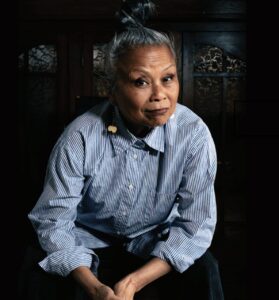
Manai Alleluia Panis is in a blue and white stripe long sleeve shirt; grey hair in a topknot; dangling Kalinga shell earnings; mischievously looking straight at the camera.
Alleluia Panis (SHE/HER/SYA; RAYMATUSH OLOHNE; SAN FRANCISCO, CA) is a choreographer and the driving force behind San Francisco, CA’s Kulintang Arts, Inc (popularly known as KULARTS). She is a respected elder artist in the US and the Philippines and is at home in both Pilipino tribal arts and American contemporary forms. Her immersive multidisciplinary work explores what it means to be a diasporic Pilipinx creative. Trained in Western dance traditions, she nurtures creative affinity, knowledge, and exchange with her indigenous folks in order to unlearn and complicate legacies of colonialism, and forced displacements. She has received grant awards from the National Endowment for the Arts,California Arts Council, SF Arts Commission, Creative Work Fund, Hewlett 50, Gerbode Foundation, Rainin Foundation Open Spaces, and NEFA New Dance Project.
She was a SF Arts Commission Artist Legacy Awardee, DanceUSA Artist Fellow, co-chair of SF Filipino Cultural Heritage District’s Arts & Culture Committee. She was a board member of API Cultural Center, Dance Bay Area, Brava for Women in the Arts, and Yerba Buena Garden Festival.
Photo credit: WILFRED GALILA

Woman wearing light tan colored hijab
Amirah Sackett (She/Her; Council of the Three Fires--comprised of the Ojibwe, Odawa, and Potawatomi Nations--as well as the Miami, Ho-Chunk, Menominee, Sac, Fox, Kickapoo, and Illinois Nations Chicago, IL) is a globally renowned hip-hop dancer, choreographer, and educator who passionately explores her Muslim American identity through the fusion of hip-hop movement and Islamic themes. Achieving viral fame through features on prominent platforms such as POPSUGAR Celebrity, The Huffington Post, AJ+, and Upworthy, she has garnered international recognition for her innovative work. Notably, Amirah was honored as one of ""17 Muslim American Women Who Made America Great in 2016"" by The Huffington Post. Her influence extends beyond performance, as she has shared her insights as a TED speaker, guest lecturer at Harvard University, and cultural diplomat with the U.S. State Department in Bangladesh, Malaysia, Kuwait, and Romania.
Amirah proudly represented the United States as a cultural performer at the Expo 2020 Dubai, the S.W.A.N.A. region's inaugural World's Fair in the United Arab Emirates. Based in Chicago, she remains committed to nurturing the next generation of artists and empowering emerging talents to utilize hip-hop culture as a catalyst for positive social change and inspiration.
Photo credit: The Barkers
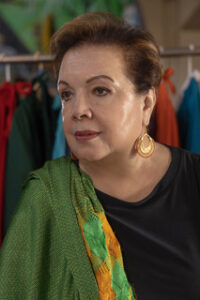
Image Description: Gema Sandoval, a Chicano with shortt brown hair , sits in front of Mexican costumes looking in the distance. She wears a black shirt and green rebozo around her shoulders.
Gema (she/her/hers; Chumash, Gabrieleno) is devoted to illuminating her Chicano heritage through dance. Over the past nineteen years, she has staged themed works, in addition to the traditional regional dances of Mexico. Among these are: “Si Se Puede/Yes You Can,” inspired by labor activist and United Farm Workers founder Cesar Chavez; Gema’s 16 year collaboration with Whittier College’s Shannon Center for the Performing Arts, “Navidad en Whittier” is now an annual tradition that serves the Latino community of the greater Los Angeles area. Her 2009 rendition of internationally renowned Chicano Author, Rudolfo Anaya’s ‘Bless Me, Ultima,’ entitled, ‘Alma Lllanera/Spirit Of The Plains’, toured throughout California. Gema’s most recent full evening production, “Immigrant Stories, An American Journey” had its world premiere in 2019 and, by popular demand, a reprisal in 2020. Currently she is working on the multigenerational choreographic collaboration with her daughter and granddaughter entitled, ‘Mujer Ayer, Hoy Y Siempre/Woman, Yesterday, Today And Always’, scheduled to be premiered in September, 2023. Along with her company, Sandoval is the winner of the 1994 and 1995 Horton Award for the Staging of Traditional Dance, a year 2000 fellow of the California Arts Council's Fellowship in Dance Program, the 2001 Irvine Foundation's California Dancemaker awards, The 2004-05 New England Foundation for the Arts National Dance Project, the 2006 Irvine Foundation's Dance Creation to Performance Fellowship and the National Association of Latino Arts and Culture and the 2015 Achievement Award from the Danzantes Unidos Statewide Organization, and, in 2016, the Soy Mexico Award from the Coalicion de Grupos Folkloricos Southern California. And most recently she received a Dance/USA 2022 fellowship for her Mujer Project.
Photo credit: Juan Escobedo
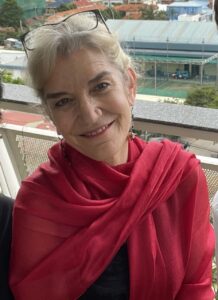
Toni Shapiro-Phim, facing the camera, is smiling. She is wearing a red scarf wrapped around her shoulders. She has gray hair.
Toni Shapiro-Phim (she/her; Massachusett, Nipmuc, Pawtucket/Waltham, MA) has focused her community work, research, writing, filmmaking, curating, producing, and teaching on the relationship between the arts and other aspects of cultural expression, and social justice and human rights concerns and efforts, in the U.S. and around the globe. Currently Director of the Program in Peacebuilding and the Arts and Associate Professor of Creativity, the Arts, and Social Transformation at Brandeis University, she edits a newsletter highlighting resources, opportunities, and other updates relevant to people in the international peacebuilding and the arts ecosystem, and designs and teaches courses on a range of arts and social justice issues. Having worked in refugee camps and war zones, her areas of expertise include arts and conflict transformation in the context of displacement and migration; war and genocide; and gender-based violence. Just this past year she presented the world premiere performance of A Deepest Blue, by acclaimed Cambodian choreographer and dancer Prumsodun Ok, and hosted a production of The Clear Blue Skies: Diaries from Ukraine, directed by Oleksandra Oliinyk and Scott Illingworth, a play in which the text comes from the recorded words of Ukrainian youth in the initial weeks after Russia’s invasion. Toni has curated exhibitions with Indigenous Canadian multi-media artist Jaime Black (Anishinaabe and Finnish), and with members of the Tibetan community in Philadelphia. A dance ethnologist, her publications include Dance, Social Justice, and Human Rights: Dignity in Motion, co-edited with Naomi Jackson; “Freedom and the Archive,” co-authored with Germaine Ingram, in Art and Human Rights; and “Embodying the Pain and Cruelty of Others” in the International Journal of Transitional Justice, among many others. Her documentary film, Because of the War, was awarded the 2018 Elli Köngäs–Maranda Prize from the American Folklore Society for “superior work on women’s traditional, vernacular, or local culture and/or feminist theory and folklore.”
Photo credit: Collection of Toni Shapiro-Phim

Zahna is a white Deaf female with dirty blonde hair pulled back wearing a black mesh leotard smiling at the camera.
Zahna Simon (Zahna/She/Her; Ohlone, Ramaytush) is a San Francisco native and Deaf from birth, Zahna Simon is honored Alumni Changemaker of the year 2018 for SF Live Oak School. She is a professional dancer, choreographer, chemist, researcher and Deaf consultant/advocate. Simon double majored in Chemistry and Dance at UCI, working with distinguished faculty such as Lisa Naugle, David Allan and Donald McKayle. A former chemist at Vertex Pharmaceuticals, she performed with various Dance companies in San Diego. Simon is the Assistant Director for Urban Jazz Dance Company, Bay Area International Deaf Dance Festival and a full time office manager at a Professional Fiduciary Office. She has been featured in KPBS TV, CBS Bay Sunday, Dance Magazine, Dance Teacher Magazine and Ikouii Creative’s Book, IN THE STUDIO, published on Stance on Dance and was a Deaf Editor for Sins Invalid Disability Justice Primer. She has performed with Kim Epifano, SF/SD Trolley Dances, Alameda Island City Waterways, Man Dance Company and Abilities Dance Boston.
Photo credit: Mark Kitoaka

In this black and white headshot, Olivier Tarpaga, a black male artist stand in front of a black and white wall. He has is hand on a leather brown hat, his face facing down and he is wearing a grey suit and a dark shirt.
Olivier Tarpaga (He/Him/His; Lenape hoking, Philadelphia, PA), is a senior lecturer in music/director of the African Music Ensembles of Princeton University and a Lester Horton Award–winning choreographer.
His music and dance work has been described as “unforgettable” by the LA Times and “extraordinary” by the New York Times, and ""Exceptionally smart work"" by Broad Street Review - Philadelphia. Tarpaga’s choreography is hybrid contemporary dance theatre with an emphasis on original live music. Since 2001 Tarpaga has conceived dynamic dance theater works, touring internationally and the US with an impressive roster of collaborators & commissioning partners: including, Kelly Strayhorn Theater (Pittsburgh), Harlem Stage, Joyce Theater, REDCAT, Crossing the Line Festival, Jacob’s Pillow, Action Danse Festival (Morocco), Charleroi Dance Biennale (Belgium), Natanda Dance Festival (Sri Lanka), and Session House (Tokyo). Tarpaga’s major works includes When Birds Refused to Fly (2019), Declassified Memory Fragment (2015), Not Because You’re African (2010), Disorder Inside Order (2008), Sira Kan (2007) and Tin Suka (2001) with Companie Ta. Tarpaga is the founder and artistic director of Dafra Drum and Dafra Kura Band, and co-founder of the Baker & Tarpaga Dance Project. He danced with David Rousseve/ REALITY from 2006 to 2010, when he was also a State Department Art Envoy in South Africa, Botswana, Burkina Faso, and Sri Lanka He has been commissioned by The Limon Dance Company, Connecticut Ballet, The Temple of Fine Arts (Perth, Australia) and MAYA Dance Theater (Singapore). Tarpaga is a recipient of numerous major grants including two NEFA’s National Dance Project (NDP) awards, the Suitcase Fund from New York Live Arts, Mellon artist in residence grant, a Chime Mentorship Fellowship with David Rousseve as his mentor, the Durfee Foundation, and grants from the Ohio Arts Council. Tarpaga has performed and taught dance and music in sixty countries throughout Africa, Europe, the Americas, Asia, and Oceania.
Photo credit: Solnicka Volna

profile picture of an older white person with a dyke-y short haircut
Arwen Wilder (he/she/they; Mni Sota Makoce/ Minneapolis, MN) makes dances. Arwen has been collaborating with Kristin Van Loon under the name HIJACK since 1993. They have made dozens of dances for hundreds of locations with the question "How can unlikely people or things co-habitate?" as their main obsession. Arwen has also taught composition and improvisation for many years, worked as a Pilates Instructor and Cranial Sacral therapist, helped two children grow up and helps to put on an enormous community puppet extravaganza/ritual every fall.
Photo credit: Heidi Eckwall
This peer reader chooses to be anonymous.
This peer reader chooses to be anonymous.
This peer reader chooses to be anonymous.
This peer reader chooses to be anonymous.
This peer reader chooses to be anonymous.
Round Two Panelists (2021-2023)
- Charya Burt (she/her; Windsor, CA) Dancer, Choreographer, Vocalist and Teacher of Classical Cambodian Dance, Founding Artistic Director of Charya Burt Cambodian Dance
- Tony Duncan (Apache, Arikara and Hidatsa; he/him; Gilbert, AZ) Performer, Hoop Dancer, Flutist
- Monique Jenkinson (Ramaytush/Ohlone; San Francisco, CA; she/her) Artist, Choreographer, Performer and Writer
- Naomi Gedo Diouf (she/her; Muwekma Ohlone Indian Tribes Castro Valley California) Cultural Bearer, Historian, Facilitator Instructor, Artistic Director of Diamano Coura West African Dance Company
- Paloma McGregor (she/her; New York, NY) Dance-maker, Co-Founder and Artistic Director of Angela’s Pulse
- Hope Auerbach Mohr (she/her; San Francisco, CA) Choreographer, Curator, Community Organizer, Writer, Founder and Co-Director of The Bridge Project
- Marissa “Mia” Morris (she/they; Piscataway; Rockville, Maryland) Visual/Performing Artist, Arts Educator, Executive Director of Dance for All Bodies
- Corbett Joan OToole (she/her; Livingston, TX) Disability Community Elder, Disability History Expert, Writer, Artist, Pubic Speaker
- Awilda Rodríguez Lora (she/her; Borikén/San Mateo de Cangrejos; San Juan, Puerto Rico) Performance Choreographer, Cultural Entrepreneur, Artistic Director at La Rosario in Santurce
- Amirah Sackett (Chicago, IL) Hip-Hop Dancer, Choreographer, and Teacher, Cultural Diplomat
Round Two Peer Readers (2021-2023)
- Pelenakeke Brown (she/her) Artist – Other/Nomad
- Madison Cario (they/them) CEO, Minnesota Street Project & Foundation – CA
- Thaddeus Davis (he/him) Co-Director Wideman Davis Dance – SC
- Thomas F. DeFrantz Director, SLIPPAGE: Performance|Culture|Technology – NC
- DejaJoelle Healing Artist and Cultural Healing Curator, Body Prayers – MN
- Ambre Emory-Maier (she/her) Artist/Stager/Teacher – OH
- rachel hickman (she/her) Creative Co-Conspirator, Kinetic Light – NM
- Millicent Johnnie (pronoun flexible) CEO, Millicent Johnnie Films, LLC – SC
- Alison Kopit (she/her) Cultural Worker – PA
- Maia “Rah Fyah” Maiden (she/her) Maia Maiden Productions – MN
- Patrick Makuakane (he/him) Founder/Director, Nā Lei Hulu i ka Wēkiu – CA
- Murda Mommy (Chicago, IL)
- Lisa Nelson (she/they) Artist – VT
- Alleluia Panis Executive & Artistic Director – CA
- Joycelyn Reynolds Executive Director, Arts New Orleans – LA
- Deneane Richburg MN
- Leslie Roybal (she/her) Program Director, Flamenco Vivo Carlota Santana – NY
- Vanessa Sanchez (she/her) Founding Artistic Director, La Mezcla – CA
- Zahna Simon (Zahna/she/her) Artist & Assistant Director of Urban Jazz Dance Company/Bay Area International Deaf Dance Festival – CA
- Cheri Stokes (she/her) Independent Artist & Associate Producer of Special Projects at Urban Bush Women – NY
- Arwen Wilder (she/they) choreographer and dancer – MN
- Taja Will (Taja/they/them) Choreographer, Performer & Healing Justice Consultant – MN
- Nancy Xiong (she/her) Artist – MN
- Anonymous Peer Reader MN
- Anonymous Peer Reader TX
- Anonymous Peer Reader AZ
Round One Panelists (2018-2020)
- T. Lulani Arquette (she/her) President, Native Arts & Cultures Foundation, Portland, OR
- Adriana Gallego (she/her) Chief Operating Officer, National Association of Latino Arts and Cultures, San Antonio, TX
- Indira Goodwine (she/her) Former Managing Director, Camille A. Brown and Dancers, New York, NY
- Jeremy Guyton (he/his) Director of Youth Programs, Dancing Grounds, New Orleans, LA
- Lily Kharrazi (she/her) Sr. Programs Manager, Alliance for California Traditional Arts, San Francisco, CA
- Toby MacNutt (they/their) Artist, Author, Teacher, Burlington, VT
- Tanya Mote (she/her) Associate Director, Su Teatro Cultural & Performing Arts Center, Denver, CO
- Judith Smith (she/her) Founder and Director Emerita, AXIS Dance Company, Oakland, CA
- Katrina Toews (she/her) Consultant and Former Director, The Washington Ballet @ THEARC, Aspen, CO
- Jawole Zollar (she/her) Founding Artistic Director, Urban Bush Women, New York, NY
